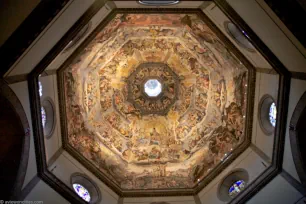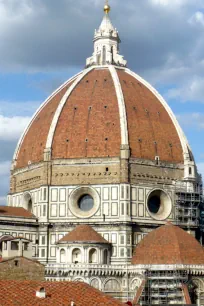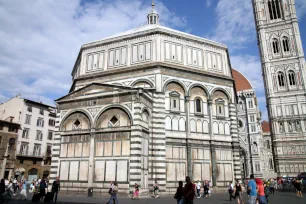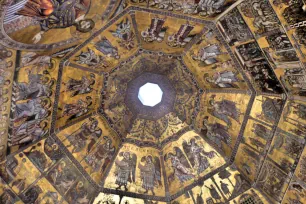The Duomo di Firenze, the cathedral of Florence, was built between 1296 and 1436. Despite its age, the cathedral is still one of the largest in the world. Its imposing dome, attributed to the Florentine architect Filippo Brunelleschi, still dominates the city skyline.
Cathedral


The Cathedral of Florence, officially known as Cattedrale Santa Maria del Fiore but better known as the Duomo, was originally planned in 1296 as a Gothic cathedral by Arnolfo di Cambio. It replaced the church of Santa Reparata, a cathedral church with a history going back to the early Middle Ages.
The new cathedral symbolized Florence’s growing importance and was to be significantly larger than its predecessor.
Francesco Talenti, who lead the construction of the cathedral from 1351 on, increased its size even more by expanding the apses and extending the nave. Filippo Brunelleschi – the most important architect of the early Renaissance – designed the Duomo’s most striking feature, the enormous dome.



Construction of the church would last until 1436 when it was consecrated by pope Eugene IV. The originally planned Gothic front facade however was unrealized. The magnificent marble cladding that we see today was only added much later, between 1871 and 1887, in a Neo-Gothic style with colorful patterns. As a result, the facade nicely complements the design of the cathedral’s fourteenth-century bell tower. Some statues that were created for the originally planned facade are now on display at the Museo dell’Opera dell Duomo, a nearby museum dedicated to works of art from the cathedral.
The cathedral’s interior is less colorful and decorations were kept to a minimum. The exception is the fresco on the dome’s interior, painted between 1572 and 1579 by Giorgio Vasari and Frederico Zuccari. The fresco depicts the Last Judgment. The marble floor with intricate patterns is also worth a look.
Dome
The dome of the Duomo was the world’s largest when it was completed in 1436 and still towers over the city. The lantern on top of the dome was added later, in 1461, by Michelozzi Michelozzo. The dome, a marvel of engineering, was designed by Brunelleschi, who submitted his plans after he went to Rome to study the Pantheon, which long had the world’s largest dome.
Brunelleschi managed to create the enormous dome without supports thanks to an ingenious design which consisted of an inner shell made of bricks with a herringbone pattern and a horizontal stone chain, which reduced stress and allowed the weight to be evenly distributed. The outer, much smaller shell supports the roof and protects the inner shell from the elements. Between the two shells is a staircase, which leads visitors to the base of the lantern.
Campanile
The bell tower of the cathedral was originally designed in 1334 by Giotto di Bondone, at the time the official master builder of the city. After Giotto died in 1337 the bell tower was completed first by Andrea Pisano and later by Francesco Talenti. The eighty-five-meter-high tower was completed in 1359. The colorful facade is clad with green, pink and white Tuscan marble. The relief decorations were created in terracotta by Andrea Pisano.
The tower is accessible to visitors and offers a magnificent view of the city and the cathedral’s dome in particular.
Baptistery


The Baptistery is one of Florence’s oldest buildings and predates the cathedral. It was constructed on top of Roman foundations, possibly as early as in the sixth century. The interior dates back to the thirteenth century, when the mosaics on the ceiling – depicting stories from the bible – were created. The exterior white and green marble cladding was added around the same time. The facade cladding was so popular that it became a model for many other baptistery and church facades in Tuscany.
After the interior and cladding were finished, the Guild of the wool merchants – who funded the renovation – decided to replace the wooden doors with new bronze ones.
The south doors were created in 1336 in a Gothic design by Andrea Pisano and depicts ecclesiastical scenes. A succession of disasters, including an outbreak of the plague, postponed the creation of the other doors.

Finally, in 1401, the Wool Guild organized a competition to select a design for additional new doors. Seven artists submitted panels, and in 1403 a design by Ghiberti was selected.
The panel submitted by Ghiberti’s main rival Brunelleschi however – on display in the Bargello – is now considered the first Renaissance artwork as it departed from the prevailing Byzantine art style by using perspective and showing realistic depictions of humans and their environment.
Ghiberti completed the panels for the north doors in 1424 after which he started working on the east doors, which were finally completed in 1452. These last doors, depicting scenes from the bible, are considered Ghiberti’s best work and have been described by Michelangelo as the Gates of Paradise. The panels have long been replaced by replicas, the originals are now on display at the Museo dell’Opera del Duomo.
Museo dell’Opera del Duomo
This museum, located nearby at Piazza del Duomo 9, is dedicated to the history and construction of the Cathedral of Florence. The museum has a valuable collection of artwork from the cathedral, such as sculptures, reliquary, religious paintings and the original panels of the doors of the baptistery. Tools used for the construction of the cathedral are also on display.
